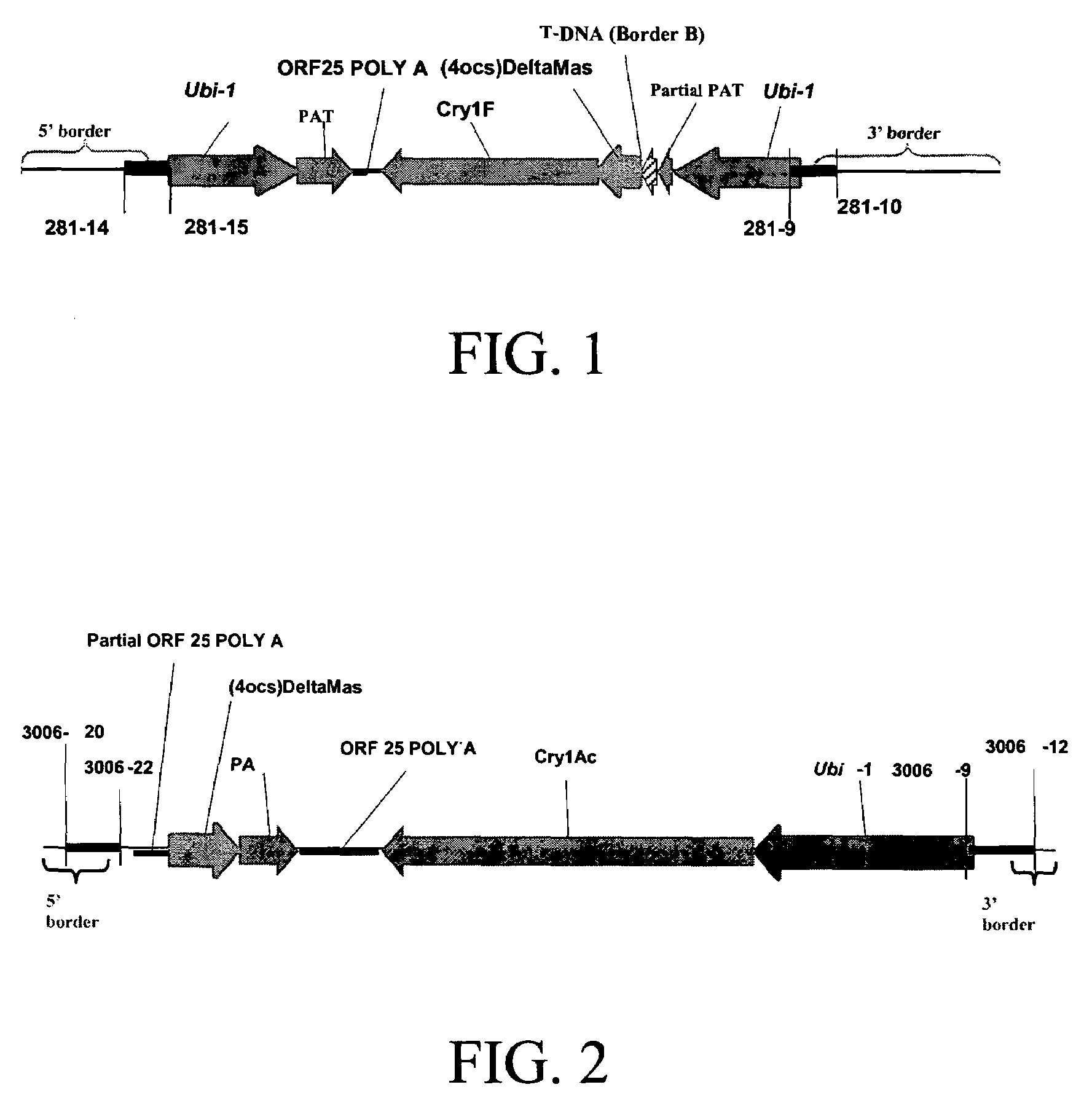Cry1F and Cry1Ac transgenic cotton lines and event-specific identification thereof
a technology of cry1ac and cotton, which is applied in the direction of peptides, bio chemistry apparatus and processes, etc., can solve the problems of inability to discriminate between different events, methods may not be useful for hypothetical insecticidal proteins, and the like. no such procedures and materials were specifically known, and the effect of low probability
- Summary
- Abstract
- Description
- Claims
- Application Information
AI Technical Summary
Benefits of technology
Problems solved by technology
Method used
Image
Examples
example 1
Production of Deposited Seed
[0108]WideStrike™ brand insect resistance for cotton is a transgenic trait developed by Dow AgroSciences that provides in-plant insect resistance against Lepidoptera. It contains two insect tolerance genes, cry1Ac and cry1F, which were derived from Bacillus thuringiensis subspecies kurstaki and Bacillus thuringiensis subspecies aizawai, respectively. Bacillus thuringiensis (B.t.) is a common, gram-positive, soil-borne bacterium. In its spore-forming stage, it produces several insecticidal protein crystals (known as delta-endotoxins) including Cry1Ac and Cry1F. These proteins are toxic to certain lepidopteran insects. In susceptible insects, they bind to specific receptors present on midgut epithelial cells, forming pores that disrupt osmotic balance and eventually result in cell lysis and death. Cry1Ac and Cry1F have been shown to be non-toxic to humans, livestock, and beneficial insects, which do not have binding sites for the delta-endotoxin. Using two ...
example 2
Diagnostic Test for Cry1F Cotton Event 281-24-236
[0110]DNA from Cry1F event 281-24-236 and Cry1Ac events 3006-210-23, and non-transgenic cotton PCS355 was extracted from cotton leaves using QIAGEN's Plant DNeasy kit (catalog # 69181, Qiagen, Valencia, Calif., USA). The manufacturer's suggested protocol was followed. In brief, leaf discs were disrupted in an RNAse supplemented preheated buffer using a tungsten carbide bead (0.125 mm diameter) and a Retsch MM3000 Mixer Mill. The mixture was centrifuged at room temperature, and the supernatant was subsequently captured by running through a DNeasy 96 plate. DNA was eluted in an elution buffer and stored frozen until use.
[0111]The DNA extracted from the cotton leaf tissue was used in a PCR DNA amplification of the 5′ genomic / transgene insert sequences in Cry1F event 281-24-236 using primer 281-14 (SEQ ID NO:3, 5′TGTCGGCTGAAGGTAGGGAGG3′) and primer 281-15 (SEQ ID NO:4, 5′ CCGGACATGAAGCCATTTAC3′), and the 3′ genomic / transgene insert sequen...
example 3
Diagnostic Test for Cry1Ac Cotton Event 3006-210-23
[0114]The DNA extracted from the cotton leaf tissue was used in a PCR DNA amplification of the 5′ genomic / transgene insert sequences in Cry1Ac event 3006-210-23 using primer 3006-20 (SEQ ID NO:9, 5′TTCCAACCTTTAACTATTATCCTGC3′) and primer 3006-22 (SEQ ID NO:10, 5′GCTGCGGACATCTACATTTT3′), and the 3′ genomic / transgene insert sequences flanking using primer 3006-9 (SEQ ID NO:12, 5′GACATGCAATGCTCATTATCTCTA3′) and primer 3006-12 (SEQ ID NO:13, 5′AAGTCTCTGCCTTCTACCCTGG3′). The PCR DNA amplification analyses were conducted using genomic DNA extracted from cotton event Cry1Ac 3006-210-23 and non-transgenic cotton line PCS355. The amplification reaction for the 5′ flanking genomic sequence was conducted using QIAGEN HotStarTaq PCR kit (catalog # 203203 or 203205, QIAGEN, Valencia, Calif., USA) with a final concentration of 0.4 μM for Primer 3006-20 and Primer 3006-22 in a 50 μl reaction volume. The reactions were performed using a GenAmp PCR ...
PUM
| Property | Measurement | Unit |
|---|---|---|
| temperatures | aaaaa | aaaaa |
| temperature | aaaaa | aaaaa |
| temperature | aaaaa | aaaaa |
Abstract
Description
Claims
Application Information
 Login to View More
Login to View More - R&D
- Intellectual Property
- Life Sciences
- Materials
- Tech Scout
- Unparalleled Data Quality
- Higher Quality Content
- 60% Fewer Hallucinations
Browse by: Latest US Patents, China's latest patents, Technical Efficacy Thesaurus, Application Domain, Technology Topic, Popular Technical Reports.
© 2025 PatSnap. All rights reserved.Legal|Privacy policy|Modern Slavery Act Transparency Statement|Sitemap|About US| Contact US: help@patsnap.com

